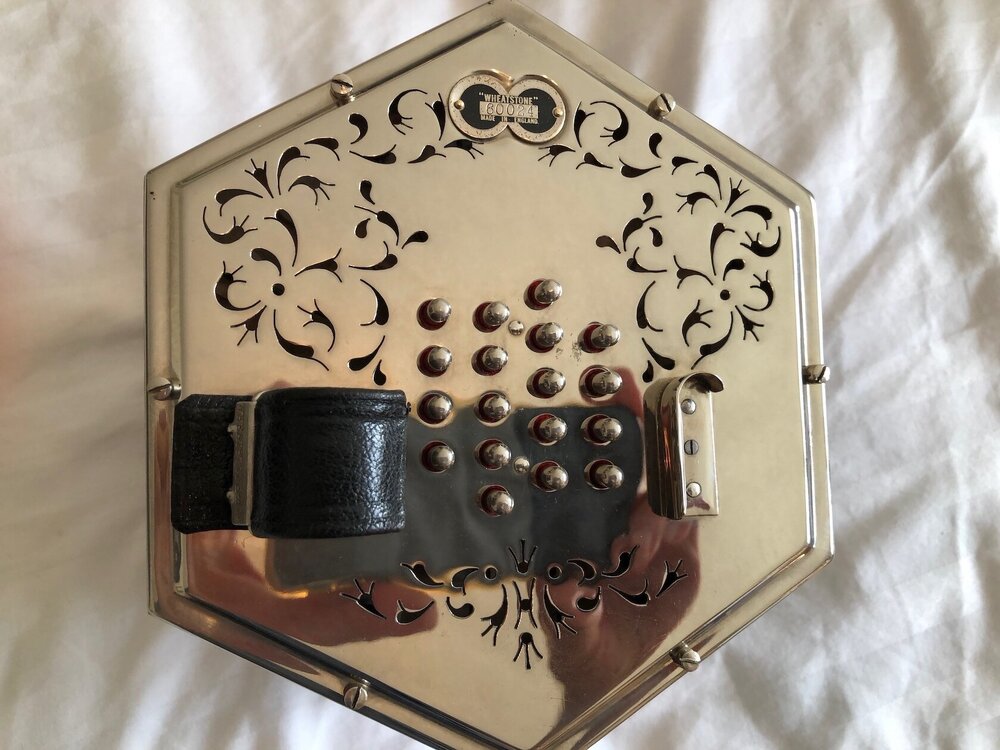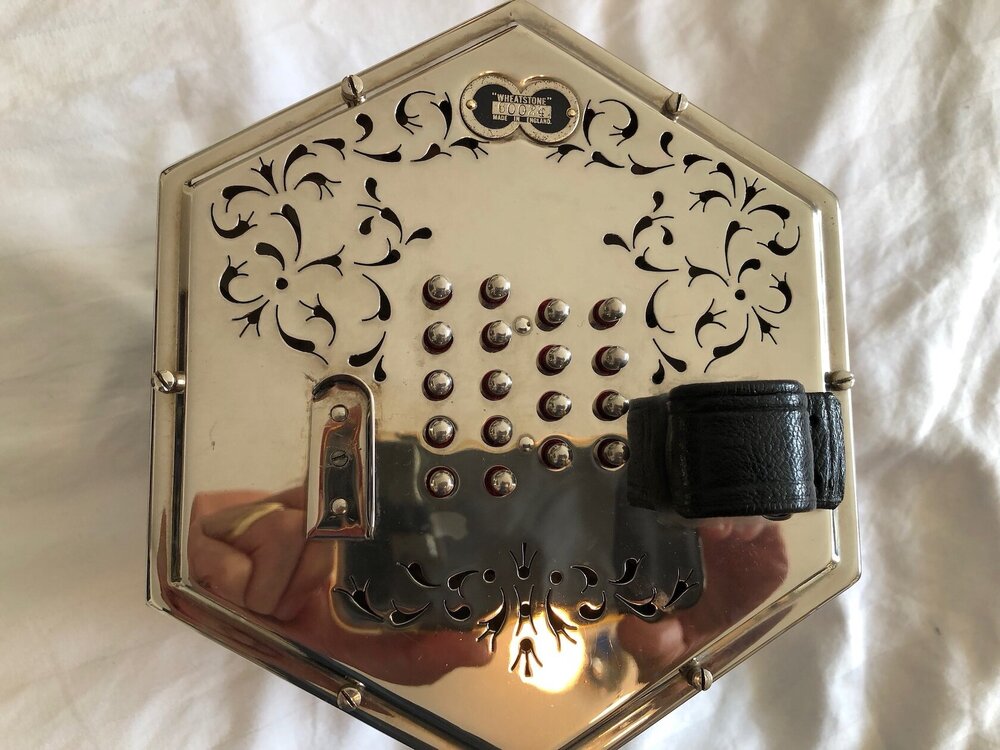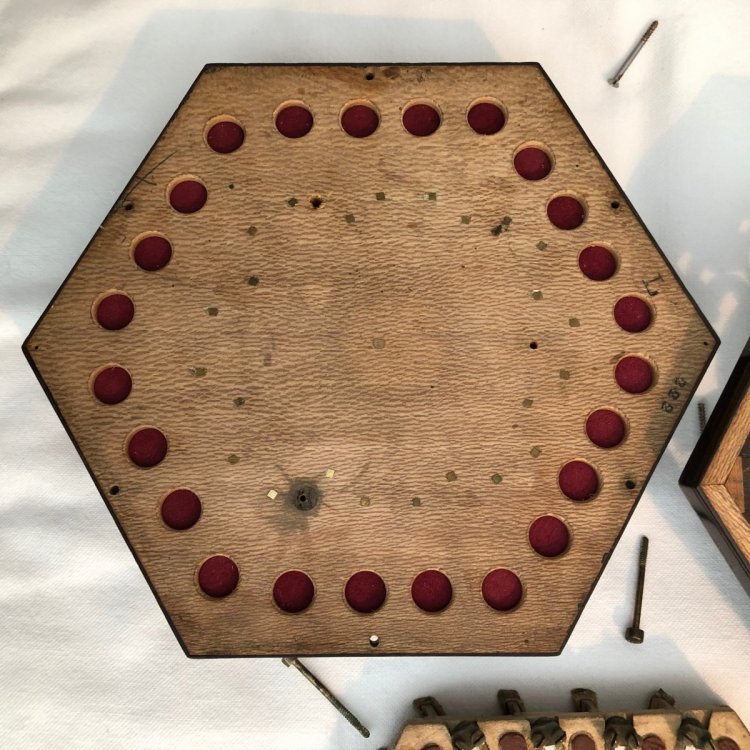
March Hare
Members-
Posts
31 -
Joined
-
Last visited
Everything posted by March Hare
-
Thank you Ken - I have been using your brilliant idea since I read your article in 2000 - so that is a quarter of a century. I had some more lessons recently and changed my LH chord playing, so the shape of the foam was altered to suit and the straps adjusted. It's a gift that keeps on giving. For a touch of luxury I sometimes cover the foam with thin, soft black leather. What a great forum for sharing ideas.
-
Hi Latzenpratz, Here's a tip I got from con.net years ago that works for me. As an anglo player with long fingers I use foam pipe insulation (cheap, comfortable, easy to cut etc). Just cut one piece the length of your handset. Then split it lengthways (like a bun for a hot dog). Put one on each handset. Then adjust your straps as you need. (You may need to lengthen yours with cord, leather strip, string or whatever.) If they feel good then put a bit of double sided tape between foam and handrest. (Personally, my middle fingers are long but my fifth fingers are not, so I slope my foam pieces to give the full thickness at the thumb end, and very little thickness at the little finger end. This foam is very easy to work with, and so cheap that you can try different styles. Surprisingly long-lasting, though.) Hope this is helpful.
-
Dickinson Wheatstone 36 key English concertina - SOLD
March Hare replied to March Hare's topic in Buy & Sell
Thank you for your message Karen. Sorry but the Dickinson is sold - I should have amended the title. I hope you find a nice instrument. Best wishes, March -
Using wool felt for baffles?
March Hare replied to Jason's topic in Instrument Construction & Repair
Thank you - that's brilliant. And very sweet playing too. -
Using wool felt for baffles?
March Hare replied to Jason's topic in Instrument Construction & Repair
May I say 4to5to6 that you have made a great job of fitting your felt - tidier that I can manage - but a pity that it didn't solve your problem. And it looks like a wonderful instrument. I enjoyed your other suggestions for absorbing the sound, particularly the rugged industrial ones. Some of my songs work best with a Bb treble EC - and I have a nice metal-ended 1960s Crabb rebuild using a great set of 1920s Wheatstone reeds. However the sound is a bit too robust for my voice. I tried playing it inside a pair of thick corduroy trousers and it worked very well. Ideal, except that I wasn't brave enough to go the club to sing like that. It really does look a bit bizarre, as you will know if you have tried it. And when you stand up the slightly worn and shiny seat of the pants catches the light, which is unbecoming and a bit distracting for listeners. So I made a pair of external baffles from two layers of felt and thin leather edging. When I sang out recently I was very pleased with the effect on the sound, and no-one made any remarks about the concertina in its garb. I am getting quite used to the look. The baffles just slide off so very quick to remove - but I keep them on anyway as I like the mellower sound. Whether or not this would placate family and neighbours when practising late at night I couldn't say. But I can revert to the trousers in the privacy of my own home. -
Dickinson Wheatstone 36 key English concertina - SOLD
March Hare replied to March Hare's topic in Buy & Sell
Ah yes - sorry - Planxty Irwin (as you all know). Lapsed viola player - same tuning as cello. Thank you Wolf - working at the Bach was a lockdown project. Bach solo cello on EC deserves a new thread - (perhaps there already is one). And thanks for all the positive comments - it is a lovely concertina. -
Dickinson Wheatstone 36 key English concertina - SOLD
March Hare replied to March Hare's topic in Buy & Sell
Plenty Irwin, Bach Sarabande, Bach Gigue. -
Dickinson Wheatstone 36 key English concertina - SOLD
March Hare replied to March Hare's topic in Buy & Sell
A couple of rough and ready recordings. Planxty Irwin.m4a Bach Sarabande.m4a Bach Gigue.m4a -
For Sale: Dickinson Wheatstone 36 key treble English concertina number 60024. Steel reeds, concert pitch, recently re-valved and fine-tuned by Concertinas UK. Excellent condition. £1650 plus £20 carriage (UK only) For further information see the Concertina Museum Collection Ref:C-114, and the Concertina Doctor 7th April 2022. It is a lovely instrument, the sound is full and rich but not at all harsh. Great feel and action, it is the most comfortable and user-friendly EC I have ever played, with all the notes that I use and without the high ones that I don’t. The images show that the condition is great, with hardly a blemish, and the bellows have no scuffing or wear and still have the smell of new leather. It has metal ends, and the wooden frames are rippled oak veneer. Range is from the usual low G3 up to D6 (2 octaves and a fifth). No low G sharp on the RHS so no key for a low F (but there is of course a low A flat on the LHS). It has fittings for wrist straps. I bought it last year because it was a rare chance to own a concertina from one of the great modern makers and it has been a joy. The folk clubs closed during lockdown so I worked on some solo Bach - and it is ideal for that. Now that I can sing out again I will go back to a Lachenal that I have sung with for nearly four decades. The Dickinson is just too good to have as a spare on the shelf - that would be a crime. I live in East Devon, and will, of course, donate to cnet if it sells from this site. (Sound files to post, below).
-
Using wool felt for baffles?
March Hare replied to Jason's topic in Instrument Construction & Repair
Hello Jason, I think the felt is worth trying. I have glued a layer of thin felt (ordinary craft felt, probably polyester rather than wool) to the inside of the fretwork on lots of concertinas. It works for me, reducing the high overtones and taking the edge off the sound. I just brush a few small smears of weak pva on the inside, no stand-offs, to cover the holes. In my experience it doesn’t shed fibres or choke the airflow, and it pulls off easily leaving negligible residue. When I sing with concertina accompaniment the felt helps my words to come across, and I feel that the instrument is supporting my voice not getting in the way. I think that this is the result of a lucky coincidence: thin felt absorbs sound noticeably above about 1000Hz but not much below that frequency. Human hearing is much more sensitive in the range from roughly 1000Hz to around 3000Hz which is (naturally) the range needed to hear the consonants in our speech, particularly T, S, K, D etc which enable us to understand what is said. So the felt baffle helps to prevent the high frequencies from the reeds from covering up the words of the song. As the listeners’ hearing is sensitive in that range the accompaniment sounds less intrusive (although the loudness measured by a meter would probably not show much difference, as the thin felt has little effect on the fundamental notes of the music). This is my rough and ready theory - the only way to find out if it works for you and your instrument is to try it. Some years back on the forum there was a post from Wim Wakker, saying that Edeophones had mahogany innards which reduced the high overtones to mellow the sound. My favourite concertina to sing with is an Edeophone and I have never wanted to add any sort of baffle. Also a New Model tenor with mahogany structure - same applies. Hope this helps. -
And these are more like Marais, I think. But, I imagine that holding a gamba like a cello is more typical.
-
-
Another try at attaching Staffs Hornpipe: Staffordshire Hornpipe.m4a
-
A tuned-up 20 key can be a good option. I bought a basic mahogany Lachenal CG from a stall at Sidmouth a while back and Concertinas UK fettled it and put it up to DA. It plays well and is quite bright. I did a quick recording of Staffs Hornpipe on my phone: Staffordshire Hornpipe.m4a So, as suggested above, worth thinking about. Good luck.
-
Hello Mikefule and thank you for opening this thread. I am a devoted 20k player and Barleycorn customer so, over some decades, I have worked up from mahogany ended Lachenals, RW ended-, to an early Jeffries/Crabb instrument - early, basic and lovely to play. More recently I saw a Wheatstone 20k on the Barleycorn site and thought it was too good to miss. It is a Linota from 1929, with RW ends and metal buttons in vg condition - it plays superbly as the very best Wheatstones of that era do, and I am very lucky to have it. So I agree with your findings: top quality 20k anglos are rare but worth waiting for. If you are looking you will find what you want eventually, I'm sure. Perhaps I should add that I have owned Anglos with more keys and, for me, they have their places and uses. But for English tunes my home is a 20k anglo, and that is where I spend many hours, and never get bored. Best wishes to all.
-
Nigel Sture.....the concertina doctor
March Hare replied to scoopet's topic in Instrument Construction & Repair
Yes, Nigel is a lovely guy, a great musician and a superb concertina restorer and tuner. I never imagined that my Edeophone could play as well as it does now. Marvellous. -
In a recent ebay listing, a treble English with coloured bone buttons was referred to as a Tudor model. Perhaps that is what your wonderful creature is playing.
-
Hello Ciaran, Great to read your posts. Very best wishes to you on joining the family firm. A visit to Chris at Barleycorn is always a real treat, and owning and playing his wonderful concertinas gives me such pleasure. And of course I recommend Barleycorn Concertinas totally - no question. And can I add, you bring such experience and accomplishment as a brilliant professional musician to the firm. Your dad is lucky to get you - and then he is a fine musician and songwriter too......... Again, very best wishes, Steve (Sidmouth)
-
-
-
This Roylance treble came back from Concertinas UK recently and may be of interest. As always, Nigel Sture did a wonderful job of restoring, fettling and tuning, and he turned a wreck into a lovely concertina. It came to me by chance. I bought a couple of Lachenal 20 key anglos last year, and this English treble came with them in the cardboard box. The fretwork was damaged and missing in places, the thumb and finger rests were gone, and a lot of the buttons were broken or lost. Not for me, I thought…..except, some of the reeds still played and sounded good. So I opened it up and found top quality workmanship: the action board and frames are lacewood (London plane), the ends are lovely solid Brazilian rosewood, all of the woodwork so carefully done, the buttons exquisitely turned, riveted action, all reeds present and in good shape, and no warping, splitting or internal damage. I repaired the ends, frames etc and managed to piece together the remaining bits of the delicate gold foil label - tricky. Nigel Sture did the rest: bushings, straps and finger-rests, buttons, all new springs, pads, valves, setting up and tuning. It has smart new bellows from Mark Adey, black and gold papers, plays effortlessly and sounds lovely. For a singer, the evenness of response is superb. When you start to play a chord of 5 or 6 notes very quietly, every note sounds at exactly the same time, and you can sustain the chord for ages on one pull, and get lots of volume when you want it. Decent reeds and, most of all, wisdom and expertise from Nigel Sture - fabulous work. I don’t know whether lacewood is often used in concertinas, or what it contributes to the sound. I know of it as a pretty native hardwood used for guitar back and ribs (rarely?). Probably an expensive concertina when new, given the quality of materials and craftsmanship - I understand that the coloured buttons (black and white notes like a piano, and red Cs like a harp) were not confined to cheap tutor instruments. Hope this is of interest. I will try to post some images, and look forward to playing it a the folk club…. sometime….. Cheers.
-
If you know anyone near to Sidmouth who might be interested in starting 20 key CG anglo, please let them know about this. Squeezebox Starters Come and learn the 20 key anglo concertina For beginners - no experience needed Tuesdays at 2pm, starting on 21st January 2020 (except 2nd Tuesday of the month). Venue: Dissenter of Sidmouth (Leigh Browne Room) May Terrace, All Saints Road, EX10 8ER (near Sidmouth Hospital) To book a place call Steve Minett on 07511 973 603 We will have fun
-
Lachenal 20 key CG anglo in great condition - now sold
March Hare replied to March Hare's topic in Buy & Sell
Now sold (elsewhere). Thank you for looking. -
Lachenal 20 key CG anglo in great condition - now sold
March Hare replied to March Hare's topic in Buy & Sell
-
Lachenal 20 key CG anglo in great condition - now sold
March Hare replied to March Hare's topic in Buy & Sell





















